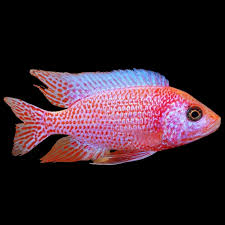Midwest Aquarium and Pond Supplier LLC
(108) Pink Dragon Blood Peacock Cichlid 3in
(108) Pink Dragon Blood Peacock Cichlid 3in
Precio habitual
$100.00 USD
Precio habitual
Precio de oferta
$100.00 USD
Los gastos de envío se calculan en la pantalla de pago.
Cantidad
No se pudo cargar la disponibilidad de retiro
The Pink Dragon Blood Peacock Cichlid (Aulonocara sp. hybrid) is a selectively bred, hybrid African cichlid known for its vibrant pink and orange coloration. It is not a wild species and is primarily found in the aquarium trade. The care for this fish is similar to that of other Peacock cichlids from Lake Malawi.
Tank and water requirements
- Tank size: A minimum of a 55-gallon tank is recommended for a small group, with 75 gallons or more being ideal, especially if housing multiple males.
- Substrate: Use a fine, sand-like substrate, as these cichlids are bottom-sifters. Coarse gravel can injure their gills.
- Filtration: A robust filtration system is essential to handle their bioload and maintain clean water conditions.
-
Water parameters:
- Temperature: Maintain a stable temperature between 76–82°F.
- pH: A high pH of 7.8–8.6 is necessary to replicate their native Lake Malawi habitat.
- Decorations: Provide plenty of stacked rocks, caves, and crevices to create territories and hiding places. Ensure there is also ample open swimming space.
Diet and feeding
- Omnivorous diet: Pink Dragon Blood Peacocks are omnivores that benefit from a varied diet.
- Food types: A combination of high-quality cichlid pellets or flakes, supplemented with live or frozen foods like brine shrimp and bloodworms, is recommended.
- Feeding schedule: Feed small amounts once or twice daily, ensuring all food is consumed within a few minutes.
Temperament and tank mates
- Semi-aggressive: They are generally more peaceful than mbuna cichlids but can display territorial behavior, especially toward other males.
- Social dynamics: To minimize aggression, keep a male-to-female ratio of at least 1:3.
- Tank mates: They are best kept with other similarly sized and tempered Peacock cichlids (Aulonocara species) and Haps (Haplochromine cichlids). Avoid smaller, more passive fish.
Breeding
- Maternal mouthbrooders: Like other peacocks, the female carries the fertilized eggs and fry in her mouth for protection, usually for about three weeks.
- Spawning behavior: Males will court a female and dig a small pit in the sand for spawning.
Share
No reviews

